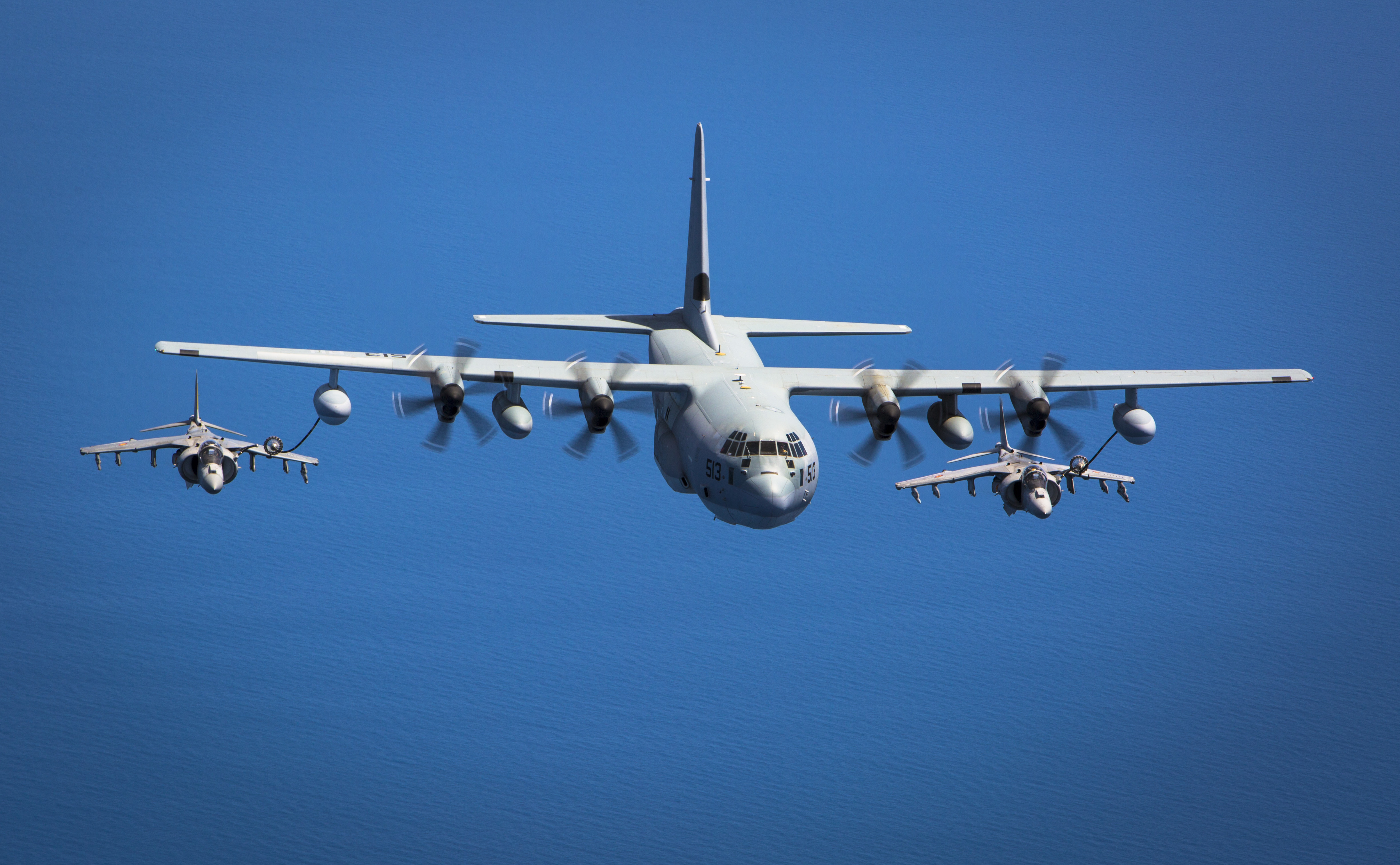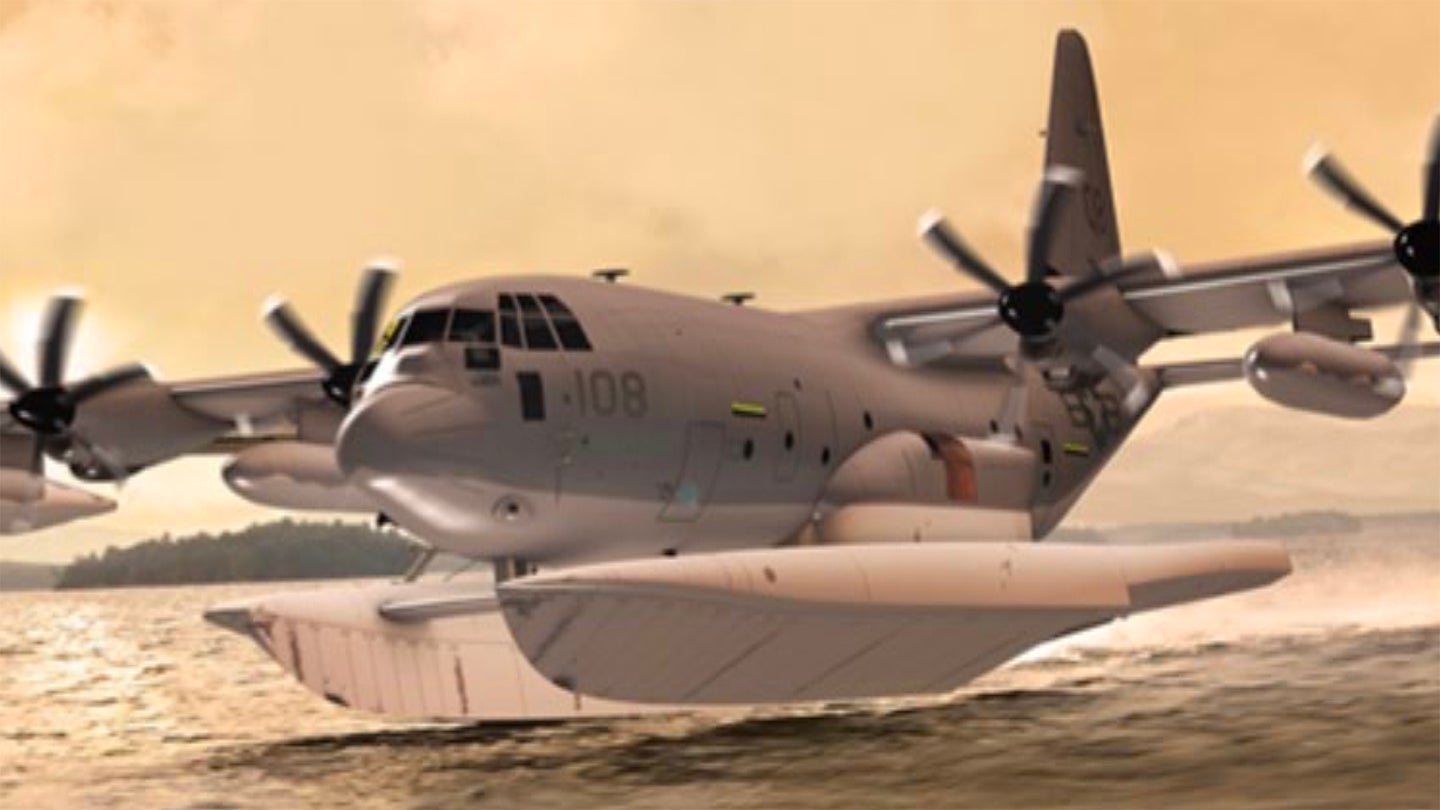C 130 Amphibious - There have been proposals for an amphibious C-130 Hercules in the past, but the US special operations community can make it a reality.
The US military is again looking at the potential of the amphibious version of the C-130 Hercules to operate from coastal areas in support of special operations forces. The project, which is in its early stages, has provided an artist's concept of an MC-130J Commando II multirole combat transport equipped with large fuselage-mounted floats. The MC-130J is the latest version of the Air Force special operations Hercules, designed to penetrate restricted areas to insert, extract or resupply special operations forces, as well as to refuel helicopters and helicopters.
C 130 Amphibious

The new effort, known as the MC-130J Amphibious Capability, or MAC, was unveiled today at a briefing given by US Air Force Col. Ken Kuebler, US Special Operations Command's (SOCOM) program executive for the Immobile Wing (PEO- FW). , at the annual Special Operations Forces Industry Conference (SOFIC). At a media roundtable later in the day, Kuebler added that feasibility studies and operational studies related to the project are currently underway, and that the command is working with unspecified "innovative partners" to hopefully prove much of the concept with using digital design tools. This, in turn, can help speed up research and development and help reduce costs.
Warbird Information Exchange • View Topic
A US Air Force II Commando MC-130J performs an in-flight refueling mission off the coast of Okinawa, Japan.
A slide from Col. Kuebler's conference mentioning the MAC concept as one of a number of "areas of focus" for SOCOM PEO-FW., SOCOM
It is important to note that while Kuebler's conference concept art, seen at the top of this article, shows large cruises added to the MC-130J, he emphasized that the MAC concept calls for an amphibious aircraft capable of operating from The Earth. , as well as bodies of water. The basic floatplane would not be able to operate from land, but adding wheels to the float could give it that capability. There are other possibilities for how the aircraft can become truly amphibious.
The basic idea of a waterborne C-130 has been around for decades and is a concept some parts of the Pentagon have considered in the past. In fact, the aircraft's original manufacturer, Lockheed, fielded a fully amphibious Hercules with a boat-like hull in the 1960s without success, although the US Navy did at least undertake studies using a scaled-down, radio-controlled version. Lockheed has since become Lockheed Martin, which is the current manufacturer of the C-130J family, including the MC-130J.
Ussocom Seeks Amphibious Mc 130 & Remote Gunship
The ability to fit a C-130J variant with pontoon-like floats attached to the fuselage, as seen in the PEO-FW concert art, is also not new. Lockheed Martin offered just one version of the plane in the late 1990s, reportedly after it received interest from the US Navy as a way to get SEAL teams and their specialized craft in and out of coastal areas.
Of course, attaching large floats to the Hercules would impose serious drag and weight penalties, reducing range and payload capacity, although it is not unheard of for seriously large aircraft to operate on floats.
However, given the amphibious requirement, it could be that the concept art is simply a re-use of old seaplane artwork, and not necessarily exactly what SOCOM now has in mind for its Naval Hercules. While a boat-like hull wouldn't have such a negative effect on performance, it would require a more significant redesign, and that's not something Lockheed Martin is known to be working on recently.

Regardless of the exact configuration, the MC-130J amphibious vehicle can provide new and emerging capabilities to the US special operations community, particularly as part of future expeditionary and distributed operations. The US military, in general, has explored concepts of operations in recent years that focus heavily on the ability to operate from austere and remote areas with very limited infrastructure in the event that large, established bases are destroyed or otherwise inaccessible.
Us State Department Approves Sale Of 12 C 130j 30 Super Hercules To Egypt
Air Force MC-130J crews are already trained to operate in precisely these types of environments, and there have been many efforts in the past to expand the ability of the Commando II, as well as the MC-130H Combat Talon II, to operate from multiple . limited areas with little or no infrastructure. You can read more about these initiatives in this previous Warzone feature.
At the same time, the US special operations community as a whole is currently in the process of considering how it can contribute to higher-level conflicts, including against nearby adversaries such as China or Russia, and in particular in the vast expanses of the Asia-Pacific region. Region. This includes operating from small islands in the Asia-Pacific region, where there may not be enough space on some small islands to quickly establish a suitable runway. The amphibious aircraft could be the ideal solution, especially during a conflict when existing airfield infrastructure could be put under significant threat if not destroyed in the first wave of attacks.
During the media roundtable, Col. Kuebler said potential conflicts with "peer and related" adversaries and "other threats" were some of the driving forces behind the MAC project. He also acknowledged that the aircraft could be particularly valuable in the Pacific Ocean, but also emphasized that it would be able to operate from any location where there is water.
An amphibious C-130 can also perform a wider range of missions beyond those of the standard MC-130J, and Kuebler said he "wouldn't make that assumption" when asked if the MAC aircraft would have the same mission assignment as the Commando II . If the guided Hercules is finally realized, various elements of the US military, outside of the special operations community, may be very interested in purchasing them.
Grumman Hu 16 Albatross Amphibious Flying Vessel Editorial Stock Image
A 2016 US Marine Corps "Toolkit" of existing and hypothetical capabilities for use in tabletop wargame development includes a section on seaplanes, with a clear emphasis on operations in the Pacific. A slide from that document, seen below, provides data for the float-equipped Cessna 208 Caravan, the Bombardier (now Viking Air) CL-415MP amphibious aircraft, and the Japanese US-2 amphibious aircraft and their respective ranges operating from Manila in the Philippines.
"Heroplanes are a proven and cost-effective operational capability that can provide lines of communication for remotely distributed EAB sites that lack port or airport infrastructure," the document states. EAB stands for Advanced Expeditionary Base Operations, a broad concept for conducting expeditionary and distributed operations developed by the Marine Corps, which you can read more about here.
The inclusion of the US-2, which is currently in service only with the Japan Self-Defense Force and is primarily used for search and rescue, underscores the importance of such aircraft in the Pacific and the other missions they can perform, including non-combat .. the role of rendering disaster relief and humanitarian aid. China is also hard at work on its own much larger amphibious vehicle, the AG600, which is expected to have an important military or at least paramilitary role, particularly in support of man-made islands and other infrastructure in the bitterly contested south. China Sea.

With all of this in mind, outside of the Navy and Marine Corps, the US Coast Guard may be another service that may be interested in the Hercules amphibious vehicle. It is a C-130 operator, and a waterborne version can function as a long-range search and rescue aircraft, allowing survivors to be picked up directly from the sea, thousands of miles offshore, ensuring that weather and sea conditions allow this. It's also worth noting that the Coast Guard operated the HU-16 Albatross amphibious aircraft in the 1980s.
Us Socom Is Upgrading Its Biggest Planes To Compete With China
A seaplane variant of the Hercules could also be suitable for the types of aerial firefighting missions now undertaken by the Air National Guard's C-130 with the Modular Airborne Fire Fighting System, or MAFFS.
While it remains to be seen how the MAC effort will progress and what specific types of roles a potential MC-130J amphibious vehicle could take on, Kuebler made it clear he believes there is "sufficient command interest" in it. I hope this has been discussed at length. The concept will finally become a reality. Air Force Special Operations Command says it needs the MC-130J on floats, and appears to have a plan to get it.
In May, we reported the fact that the US Air Force Special Operations Command (AFSOC) really wanted to make the long-held dream of a C-130 seaplane a reality. In fact, the so-called MC-130J Amphibious Capability, or MAC, was listed as one of the new procurement priorities. While we had a tiny little sketch of what this might look like when we submitted this report, as well as other historical design concepts, we now have a much better look at what they want, and yes, it is a C-130 on water .
In fact, they have presented a number of similar seaplane concepts, some with a more traditional look, while others are more streamlined, conforming and futuristic. Capabilities appear to include the requirement for amphibious operations. In other words, the MC-130 still can
Ever Ready For The Fight Against Boko Haram
C 130 toy plane, amphibious vehicle r c, c 130 toy airplane, c 130, lockheed c 130 hercules, c 130 propeller, r c amphibious tank, lockheed c 130, r c amphibious, c 130 jobs, c-130, c wolf amphibious bush aircraft
0 Comments